





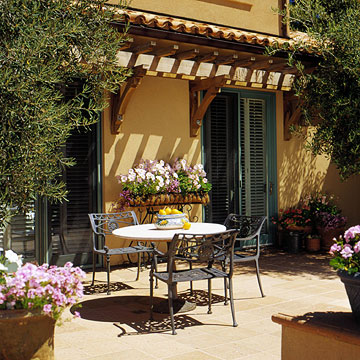 Outdoor dining areas are morelikely to be used if they'renear the house and shelteredfrom harsh winds and hot sun.
Outdoor dining areas are morelikely to be used if they'renear the house and shelteredfrom harsh winds and hot sun.
Patios, along with decks, are the workhorses of outdoor entertaining. Although many factors affect the success of a patio, the most important consideration is its location. A patio's site affects how much it is used and influences how well it serves the intended purpose.
If the patio is for outdoor dining, having it close to the house -- and kitchen -- increases the likelihood of its being used. A remotely located patio makes a great area for outdoor dining, but be realistic about how you respond to "out of sight, out of mind" situations. You may end up not using a remote patio as often as you had planned.
Designing for Outdoor Living
continue reading below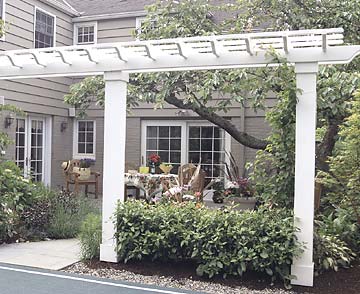 Trees provide welcome shade for
a patio; arbors are a way to add
shade instantly.
Trees provide welcome shade for
a patio; arbors are a way to add
shade instantly.
Another factor to consider when siting the patio is microclimate. A spot that is convenient to the kitchen may have too much or too little sun or an unpleasant view. Wind, sound, and privacy should also be considered. You may be able to screen the unattractive views, add shade, or remove limbs to bring sunlight into the area. Or you may need to find another location for the patio. A master plan will help in dealing with these situations.
Great Trees for Patios
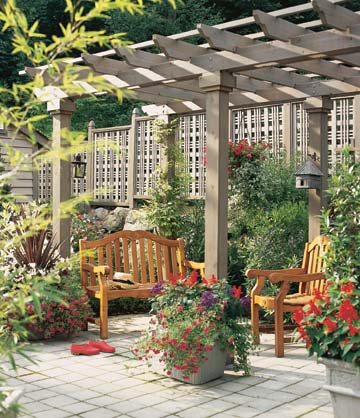 A trellis or fence can control anunattractive view.
A trellis or fence can control anunattractive view.
Consider the view from where you will be sitting. If the view is a problem, an attractive fence or trellis can be a quick solution. If a portion of the view is attractive, you can frame it with carefully positioned gaps in the screen.
Click here to find even more inspiration for your patio.
When building the patio, consider the proximity of large trees that may suffer root damage or damage the patios themselves. Even shallow roots can damage a patio in time. Also consider accessibility to utilities such as electricity for lighting or water for a fountain.
Seven Keys to Backyard Privacy
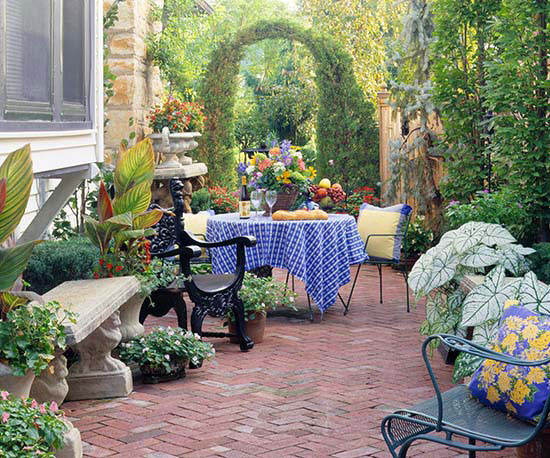 When designing a patio, choosea style and materials that fitthe surroundings. Here, atraditional herringbone brickpatio fits with the traditionalstyle of the house and garden.
When designing a patio, choosea style and materials that fitthe surroundings. Here, atraditional herringbone brickpatio fits with the traditionalstyle of the house and garden.
The design of a patio should take into account the style of the house and the surrounding garden, and the purpose the patio is to serve. One of the first considerations is the size of the patio.
A large patio is expensive and may not be necessary if you plan only intimate gatherings with family or a few friends. However, if you like large parties, or live in a neighborhood where most homes have substantial outdoor entertaining areas, a bigger patio may be a worthwhile investment.
Another consideration is levelness. A patio should provide a firm, level surface for seating and entertaining. That's one of the big advantages of a patio over a lawn, which can be a difficult base for setting up tables and chairs -- especially after a rain when it may be spongy or uneven.
Find 30 more design tips for your landscape.
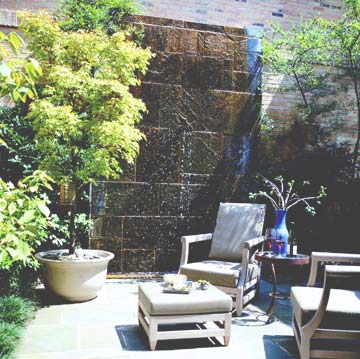 Add instant interest to patios
by using containers filled with
plants to create focal points
or to divide a large area into
more intimate spaces.
Add instant interest to patios
by using containers filled with
plants to create focal points
or to divide a large area into
more intimate spaces.
Open and airy. As a general rule, a patio is open and exposed; it visually spills into the surrounding areas. To avoid feeling exposed, consider adding a pergola or other overhead structure to give the patio a sense of containment.
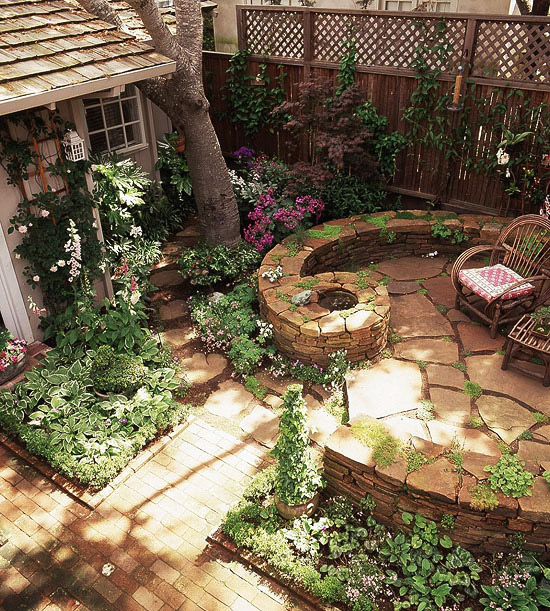 Walls and fences create a
comforting sense of enclosure
and definition for a patio.
Whatever enclosing method you
select, put it to work by
hanging wind chimes or a
bird feeder.
Walls and fences create a
comforting sense of enclosure
and definition for a patio.
Whatever enclosing method you
select, put it to work by
hanging wind chimes or a
bird feeder.
Private and secluded. A patio is a private outdoor room. You can create a sense of privacy by using the existing walls of the house or garage. You need not completely enclose the area as you would a courtyard. Instead, consider building a screen or fence to enclose part of the patio, leaving the other sides open. Partial enclosure creates a sense of intimacy, making the patio especially suited to outdoor dining.
Close to home. Having a patio close to the house has many advantages. If it's visible from inside the house, it has a tendency to be used more because you are constantly aware of it. A patio can also serve as a transitional area between the house and the garden.
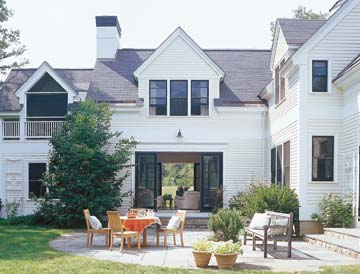 A change in level of one or two
steps creates a sense of
separation, even if the patio
is close to the house.
A change in level of one or two
steps creates a sense of
separation, even if the patio
is close to the house.
Change of grade. Add interest to a patio by having it slightly elevated or sunken. This is especially appropriate if your garden is relatively level. If you plan on setting the patio below the surrounding grade, you will need to install some type of drainage system. A raised patio will drain easily if you build the surface with a slight slope.
Underutilized area. Sometimes paving a narrow side yard or other small area can turn an otherwise unused spot into a functional patio. This is especially true of areas that receive little sunlight and might otherwise be difficult spots in which to maintain a lawn or other planting.
Copyright © www.100flowers.win Botanic Garden All Rights Reserved